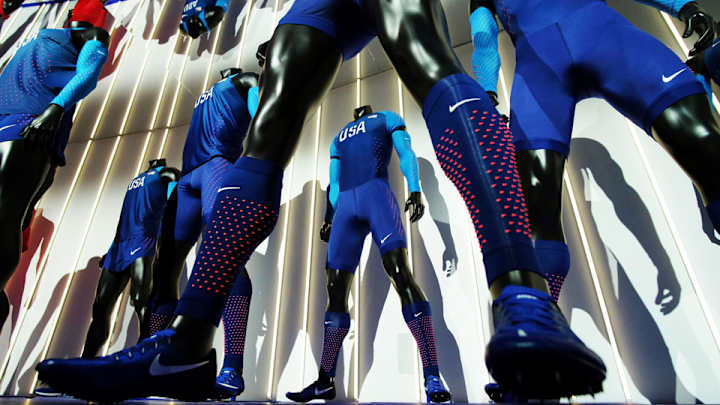Nike unveils new uniforms, technology ahead of 2016 Olympics

NEW YORK—Nike continues to look for ways to explore how fast, how high or how far the human body can push its boundaries.
The global sportswear giant unveiled its new line of uniforms and technology for the 2016 Olympics at their innovation summit in New York City on Wednesday and Thursday. The latest footwear and apparel will be on display at the Summer Games, the European Championship and the Copa America in the coming months.
Looks like these are the Nike kits that Team USA (@usatf) will be wearing in #Rio2016. pic.twitter.com/81G2s23W4N
— Chris Chavez (@ChrisChavez) March 17, 2016
Over the past couple months, Nike has consulted with its athletes and designers and tested its products in labs to provide the best performance results possible with the hopes of its athletes bringing home medals at the 2016 Summer Games in Rio de Janeiro.
***
The United States topped the medal table at the 2012 Olympics with 103 medals (46 gold, 28 silver and 29 bronze.) After London, it would be too simplistic for any Olympic athlete to walk onto the Nike campus in Beaverton, Ore., and simply ask designers to make things faster for 2016.
A lot of the responsibility for pushing Nike athletes across the finish line happens to fall on the shoulders of Martin Lotti, Nike’s vice president and creative director across several sports.
“We started with the football [soccer] kits and said ‘What if we looked at this as an entire system and not just as an individual shoe or apparel? How do all these components work together as one?’” Lotti says. “That was true for basketball, track and field and football. We linked how the sock works with the sockliner, how the shin guard connects with the sock. Then the base layer to the shorts.”
In the past, Nike tried to focus on breathability in its products by cutting holes with lasers and now they can work directly from the spool and engineer it for specification in areas where athletes need support.
“It’s not about a uniform,” Lotti says. “It’s about a system of speed.”
In 2012, Nike released its TurboSpeed track and field uniform, which was dubbed its fastest uniform ever. Tested against wind tunnels, the suit was up to 0.023 seconds faster over 100 meters than any previous kit. The 2016 kit focused on aerodynamics again. A creative team and designers spent hundreds of hours in a wind tunnel to identify the right areas and shapes to put texture on the suit.
“It seems counterintuitive to add things in hopes of making the suit faster,” Lotti says. “But if you look at a golf ball, it’s not all smooth. It has texture, too. It’s kind of the same approach where we create mini turbulences and air channels to propel the athlete forward. At the fastest moving parts of the body—the forearms and legs—you’ll see the highest concentration of those aeroblades.”
***
Nike also unveiled the uniforms for other countries, like Kenya and Brazil.
The #Rio2016 kits for @athletics_kenya. pic.twitter.com/ifWPXt7i1P
— Chris Chavez (@ChrisChavez) March 17, 2016
Brazil's Nike uniforms for #Rio2016. pic.twitter.com/TokIQRB28J
— Chris Chavez (@ChrisChavez) March 17, 2016
At the 2012 Olympics, one of Nike’s newest innovations was the FlyKnit racing shoes for their marathoners in London. Abel Kirui of Kenya wore the new shoes in a silver medal finish.
In the years since the Olympics, Adidas has won the war on the marathon with Olympic bronze medalist Wilson Kipsang setting the world record of 2:03.23 at the 2013 Berlin Marathon, a record lowered one year later by compatriot Dennis Kimetto (2:02:57). The top-five marathon times in history have been run in the Adidas Adios Boost.
In addition to a new Nike Zoom Flyknit Streak, this year’s Nike Olympic marathoners will look to go faster with turbines on their tops. It’s 2016 and that makes sense.
“This time around with the new and improved aeroblades, we have been able to apply this to our distance and marathon kits as well,” Lotti says. “This has never happened before. Previously, you had to run at a certain speed to get any benefit. Now you can have that for short and long distance.”
In the sprints, American Allyson Felix looks to complete the rare feat of winning gold medals in the 200 and 400 meters. In order to do so, she is working closely with Nike’s team of designers to perfect the speedsuit and craft the perfect spikes to run in.
“They have all the details that I know nothing about and so it's cool that I can focus on my training and they have the innovation that can propel me forward,” Felix says.
Tony Bignell, Nike’s vice president of footwear innovation, has been working closely on Felix’s double.
“Specifically for Allyson, I think she really wants to work on her start and moving around the curve. She’s very long limbed and so it takes a longer time to get up and cranking so that was the challenge she posed for us. She’s amazing and now how can we make her more amazing?”
While Felix will attempt the double, last year’s 200-meter world champion Dafne Schippers of the Netherlands is also receiving the same assistance from Nike in her pursuit of gold in Rio.
“We want to maximize the potential of every athlete,” Bignell says. “It doesn’t matter what country they’re from. Our goal is how do we make it more personal for each of those athletes since they’re all great.”
In 1996, Michael Johnson won the 200 and 400 while wearing gold spikes at the Summer Games in Atlanta. Bignell chuckled at the suggestion of another pair of gold spikes in 2016. Felix was unsure if she would be ready to fill Johnson’s shoes in the double attempt.
“Man, I think the gold spikes are his thing,” Felix says. “I can’t follow in his footsteps but I’m really excited to have a customized spike for me and for what I’m trying to accomplish.”
